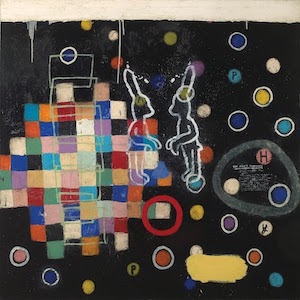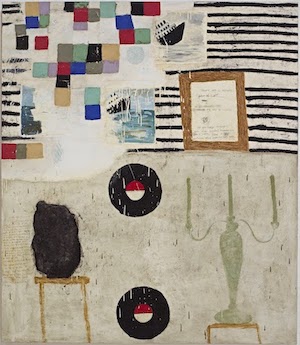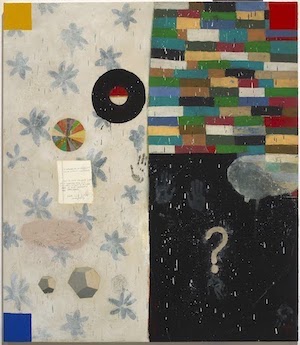Weisman Museum to Present Squeak Carnwath: How the Mind Works
 The Frederick R. Weisman Museum of Art at Pepperdine University will present Squeak Carnwath: How the Mind Works from Saturday, May 18, until Sunday, July 28. A special opening reception will be
held on Sunday, May 19, from 2 to 4 PM. There is no admission charge and the general
public is invited to attend.
The Frederick R. Weisman Museum of Art at Pepperdine University will present Squeak Carnwath: How the Mind Works from Saturday, May 18, until Sunday, July 28. A special opening reception will be
held on Sunday, May 19, from 2 to 4 PM. There is no admission charge and the general
public is invited to attend.
For over 30 years, Bay Area artist Squeak Carnwath has created bold, colorful paintings that provide a journey into the creative process. Using a personal iconography of texts, images, charts, and symbols, she explores both the philosophical and mundane experiences that fill our everyday lives. Her paintings function as fields of information, mixing words and images into reflections on our everyday lives that run the gamut from the light-hearted and humorous to the somber and serious.
Writing is a key element in Carnwath’s work. The hand-painted words and phrases that appear in her paintings arise as they do in our consciousness—sometimes through obsessive habits, often through serendipity. Rendered in a loose hand, these texts arise from various sources ranging from things she has read, said, or heard during the day, to the deep voices of inward obsession, perhaps of troubled childhood memory. Her paintings reflect on how the mind works, providing a glimpse into the rich complexities of human thought, seen from a highly personal artistic and poetic point of view.
 “It is particularly rewarding to display the work of Squeak Carnwath immediately after
a large survey of art by Richard Diebenkorn. These two artists, belonging to two different
generations, offer an overview of the San Francisco Bay Area’s incredibly creative
art scene. While Diebenkorn focused on more narrow formal concerns, Carnwath opened
the doors to a more personal perspective, exploring her thoughts, life in the studio,
and the world at large,” said Michael Zakian, director of the Weisman Museum and organizer
of the exhibition.
“It is particularly rewarding to display the work of Squeak Carnwath immediately after
a large survey of art by Richard Diebenkorn. These two artists, belonging to two different
generations, offer an overview of the San Francisco Bay Area’s incredibly creative
art scene. While Diebenkorn focused on more narrow formal concerns, Carnwath opened
the doors to a more personal perspective, exploring her thoughts, life in the studio,
and the world at large,” said Michael Zakian, director of the Weisman Museum and organizer
of the exhibition.
Squeak Carnwath’s personal style has been shaped by her response to a range of powerful 1970s art movements, including New Image painting, Conceptual Art, and above all Process Art. Throughout her career, she has been a fierce defender of painting and once declared: “I am a painting chauvinist.” At a time when many artists have shifted focus to new electronic media, she remained committed to paint on canvas because of its endless elasticity and flexibility. As she said, “ can be any form, and take on any form.”
Like New Image painting, her imagery is direct, basic, and fundamental. Favorite images represent common things—chairs, vessels, houses, ships, and so on—rendered in a seemingly casual style using shapes and emphatic black outlines. Her imagery explores the nature of thought—the way certain images gain a foothold in our minds and become part of our individual and collective personality. Certain images seem fun and light-hearted but on reflection have deeper, sometimes troubling meaning. The “Dumb Bunny,” a standing rabbit figure, refers to 1950s slang about a foolish woman.
 Negative stereotypes like this persist through society’s unthinking acceptance of
them. The “Sinking Ship” refers to our shared anxiety as we await the next disaster.
We don’t know whether it will be caused by man or nature, only that it will happen.
Black discs represent old LP records. They refer to the memory and cultural history
that shape our collective consciousness. Carnwath's images, even when highly personal,
reflect larger universal or existential themes.
Negative stereotypes like this persist through society’s unthinking acceptance of
them. The “Sinking Ship” refers to our shared anxiety as we await the next disaster.
We don’t know whether it will be caused by man or nature, only that it will happen.
Black discs represent old LP records. They refer to the memory and cultural history
that shape our collective consciousness. Carnwath's images, even when highly personal,
reflect larger universal or existential themes.
Her principal talent is transforming inert materials into something akin to living matter. In her art, every wobbly line has a character, each handwritten word has its own temperament, and dabs of color have different shapes and moods. As she once said: “Painting is a philosophical enterprise, a kind of alchemy which inert material becomes something else—a repository of the human spirit.”
Carnwath lives and works in Oakland, California. She received her MFA from California College of Arts and Crafts in 1977 and is Professor Emerita at the University of California, Berkeley. Her work is exhibited widely and is in the collections of major institutions such as the San Francisco Museum of Modern Art and The Brooklyn Museum. She has received numerous prestigious awards, among them two Individual Artist Fellowships from the National Endowment for the Arts, a Guggenheim Fellowship, and the Lee Krasner Lifetime Achievement Award from the Pollock-Krasner Foundation. She was honored with a major exhibition, Squeak Carnwath: Painting Is No Ordinary Object, at the Oakland Museum in 2009.